Bread & Milk (2003)
19th February 2010
 I got home a little later than I thought I would last night due to a delicious duck dinner and didn’t think I would have time to watch a whole movie before I slept. Turning on the tv, I saw that Hyperbole of Youth was showing on KTV but it was well into the movie, or at least past the singing nurse scene, and since I own the DVD, I kept looking. I started watching a British movie called Doomsday on another channel, but found it to be unwatchable. It seemed like it ripped off every movie from 28 Days Later to Alien 2 to Braveheart. After thirty minutes of that, I turned it off and had even less time. I decided to watch a short film instead. Earlier in the week I had recieved an order of DVDs. Among them was a collection of shorts I had been hesitant to buy because of the price. The four disk set was on sale for 40,000 won–down from 60,000–and I figured the price would not go lower than that I bought it. There was no English title on the collection, but it translates as ‘Short Films Like a Jewel in my Heart’ and consists of 25 movies–all subtitled. Among them was the film I chose to watch, Bread & Milk.
I got home a little later than I thought I would last night due to a delicious duck dinner and didn’t think I would have time to watch a whole movie before I slept. Turning on the tv, I saw that Hyperbole of Youth was showing on KTV but it was well into the movie, or at least past the singing nurse scene, and since I own the DVD, I kept looking. I started watching a British movie called Doomsday on another channel, but found it to be unwatchable. It seemed like it ripped off every movie from 28 Days Later to Alien 2 to Braveheart. After thirty minutes of that, I turned it off and had even less time. I decided to watch a short film instead. Earlier in the week I had recieved an order of DVDs. Among them was a collection of shorts I had been hesitant to buy because of the price. The four disk set was on sale for 40,000 won–down from 60,000–and I figured the price would not go lower than that I bought it. There was no English title on the collection, but it translates as ‘Short Films Like a Jewel in my Heart’ and consists of 25 movies–all subtitled. Among them was the film I chose to watch, Bread & Milk.
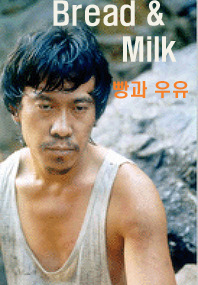 Bread & Milk is not the first film of the collection, but I remembered the title from years ago. It had won several awards at film festivals when it debuted in 2003. And after watching the story, it is easy to see why. It is the story of man, the only person we see during the entire film, and his struggle against the universe. At the beginning of the movie, he is at the end of his rope and believes he is finished. He has taken out a huge insurance policy that will help his family in the case he has an accident, and then proceeds to try to arrange a suicide that will look like an accident. However, fate has other plans for him and the man finds that his struggles with the forces of the universe are far from over. It is really an excellent film and has made me excited to see what else is in the collection.
Bread & Milk is not the first film of the collection, but I remembered the title from years ago. It had won several awards at film festivals when it debuted in 2003. And after watching the story, it is easy to see why. It is the story of man, the only person we see during the entire film, and his struggle against the universe. At the beginning of the movie, he is at the end of his rope and believes he is finished. He has taken out a huge insurance policy that will help his family in the case he has an accident, and then proceeds to try to arrange a suicide that will look like an accident. However, fate has other plans for him and the man finds that his struggles with the forces of the universe are far from over. It is really an excellent film and has made me excited to see what else is in the collection.
Bread and Milk was directed by Won Shin-yeon. Won began his career, not as a director, but as a minor actor. He debuted in a children’s film in 1991 and did not direct until 2001 with a feature length film called Jeok that never saw a release. This was followed by the very successful short film Cradle Song in 2002 and then Bread & Milk the next year. In 2005, Won tried his hand at another feature length film The Wig and then followed these with Bloody Aria and Seven Days. Director Won is currently working on a live action version of Robot Taekwon V.
The first image in this article is that of the DVD collection. If you are interested in seeing Bread & Milk or other shorts, then you should check with where you buy your DVDs to see if they can get it for you. Pricey, but worth it.
Posted in 2000s, Review, short films | Comments Off

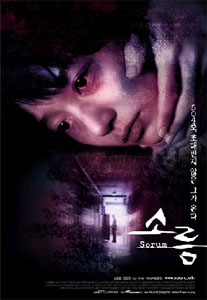 Recovered post: Originally posted March 28, 2009–Sorum is a movie I have been wanting to see for a long time. I do not know why I missed it when it was released in theaters back in August of 2001 but the dvd has been out of print until recently when it was re-issued. I had high expectations when I sat down to view the movie and, for the most part, I was not disappointed. The story is interesting, each of the small cast of characters is engrossing, and the atmosphere eerie. Not eerie enough to justify the title ‘Sorum’ which in English means ‘goosebumps’ but eerie enough to keep me in suspense. The movie is described as a thriller/horror film but the actual horror elements are minimal. Barring the re-animated hamster (which is itself a questionable event as the only witness to it is completely insane) and in any case is not especially horrifying) and the grieving Eun-soo’s dream discussions with her dead boyfriend there is little to indicated any supernatural activity save for the ramblings of a failed author with an overactive imagination. Instead, the movie should be thought of as a mystery/thriller. The viewer is not handed the answers to anything and is instead expected to work everything out for themselves. However, I expect that this movie has not been more popular because there are no clear answers and the very sudden ending that leaves even more questions than when we began.
Recovered post: Originally posted March 28, 2009–Sorum is a movie I have been wanting to see for a long time. I do not know why I missed it when it was released in theaters back in August of 2001 but the dvd has been out of print until recently when it was re-issued. I had high expectations when I sat down to view the movie and, for the most part, I was not disappointed. The story is interesting, each of the small cast of characters is engrossing, and the atmosphere eerie. Not eerie enough to justify the title ‘Sorum’ which in English means ‘goosebumps’ but eerie enough to keep me in suspense. The movie is described as a thriller/horror film but the actual horror elements are minimal. Barring the re-animated hamster (which is itself a questionable event as the only witness to it is completely insane) and in any case is not especially horrifying) and the grieving Eun-soo’s dream discussions with her dead boyfriend there is little to indicated any supernatural activity save for the ramblings of a failed author with an overactive imagination. Instead, the movie should be thought of as a mystery/thriller. The viewer is not handed the answers to anything and is instead expected to work everything out for themselves. However, I expect that this movie has not been more popular because there are no clear answers and the very sudden ending that leaves even more questions than when we began.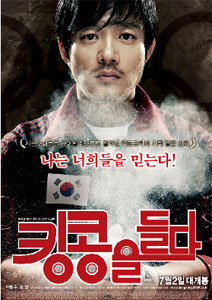 In the summer of 2009, Take Off opened and quickly proved itself to beone of the surprises of the season. That film, about Olympic ski-jumping, followed not too far behind Forever the Moment which dramatized the true story of the Korean Olympic women’s handball team… But during the course of the summer, a second movie based on an Olympic team was released–Lifting King Kong (which was erroneously called Bronze Medalist by the Korean Times). It is the story of the coach who trained the athletes of Korea’s Olympic women’s weightlifting team. But this film was far less successful than either of the other’s previously mentioned.
In the summer of 2009, Take Off opened and quickly proved itself to beone of the surprises of the season. That film, about Olympic ski-jumping, followed not too far behind Forever the Moment which dramatized the true story of the Korean Olympic women’s handball team… But during the course of the summer, a second movie based on an Olympic team was released–Lifting King Kong (which was erroneously called Bronze Medalist by the Korean Times). It is the story of the coach who trained the athletes of Korea’s Olympic women’s weightlifting team. But this film was far less successful than either of the other’s previously mentioned.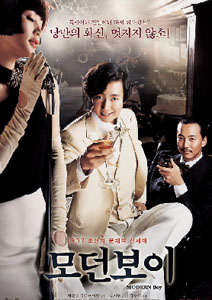 Originally posted April 26, 2009–I was really expecting to like this movie. It has two actors I really enjoy watching (Park Hae-il and Kim Hye-soo), it was directed by a man with a track record for making good films (Jeong Ji-woo of Happy End and Boy With a Knapsack from If You Were Me 2) and it is set in a time period that I usually find very interesting. Unfortunately, it is the story that ultimately brings this movie down and, while I don’t regret watching it, the movie cannot be considered more than a pleasant waste of time. It definitely will not leave a last impression once I stop trying to figure out the gaping plot holes that really have no explanation.
Originally posted April 26, 2009–I was really expecting to like this movie. It has two actors I really enjoy watching (Park Hae-il and Kim Hye-soo), it was directed by a man with a track record for making good films (Jeong Ji-woo of Happy End and Boy With a Knapsack from If You Were Me 2) and it is set in a time period that I usually find very interesting. Unfortunately, it is the story that ultimately brings this movie down and, while I don’t regret watching it, the movie cannot be considered more than a pleasant waste of time. It definitely will not leave a last impression once I stop trying to figure out the gaping plot holes that really have no explanation.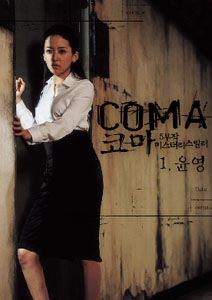 Originally posted May 17, 2009–In 2006, the Jeonju International Film Festival screened a five-part film entitled Coma. Although produced by OCN-TV and Sio to air on television later that year, the festival’s directors felt it worthy of showing as part of their Korean Cinema on the Move section. The project was overseen by director Kong Su-chang (R-Point, GP-506) who also directed the first and final chapters, Birthday Party, Doctor Jang Seo-Won). The second chapter was directed by Jo Gyu-ok (who has only done short films to date). The third, Necklace, by Yoo Joon-seok (Invisible 1–a short film) and the fourth chapter, Crimson Red, by Kim Jeong-gu, original author of Resurrection of the Little Match Girl, comprise the other 50-minutes chapters of the film.
Originally posted May 17, 2009–In 2006, the Jeonju International Film Festival screened a five-part film entitled Coma. Although produced by OCN-TV and Sio to air on television later that year, the festival’s directors felt it worthy of showing as part of their Korean Cinema on the Move section. The project was overseen by director Kong Su-chang (R-Point, GP-506) who also directed the first and final chapters, Birthday Party, Doctor Jang Seo-Won). The second chapter was directed by Jo Gyu-ok (who has only done short films to date). The third, Necklace, by Yoo Joon-seok (Invisible 1–a short film) and the fourth chapter, Crimson Red, by Kim Jeong-gu, original author of Resurrection of the Little Match Girl, comprise the other 50-minutes chapters of the film.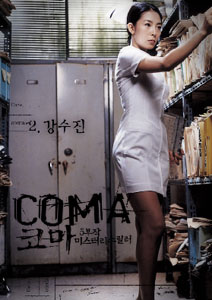 Originally posted May 17, 2009–The mystery continues. Previously we witnessed the events leading up to the disappearance of Hye-yeong. At the start of the chapter, we witnessed demolition and salvage workers opening up a mysterious sealed room in the basement of the hospital. In the second chapter we are witness to a horrific tragedy that occured therein and how events in the past are related to the future.
Originally posted May 17, 2009–The mystery continues. Previously we witnessed the events leading up to the disappearance of Hye-yeong. At the start of the chapter, we witnessed demolition and salvage workers opening up a mysterious sealed room in the basement of the hospital. In the second chapter we are witness to a horrific tragedy that occured therein and how events in the past are related to the future.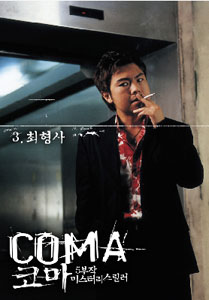 Im Won-hee, star of The Cut and Dajjimawa Lee, leads the cast in The Necklace, the third chapter of the Coma omnibus. He is the police detective assigned many years ago to the case of the missing Hye-yeong. During that time he has been carrying the girl’s necklace around calling it his cash card. Clearly he has been blackmailing the hospital’s director.
Im Won-hee, star of The Cut and Dajjimawa Lee, leads the cast in The Necklace, the third chapter of the Coma omnibus. He is the police detective assigned many years ago to the case of the missing Hye-yeong. During that time he has been carrying the girl’s necklace around calling it his cash card. Clearly he has been blackmailing the hospital’s director.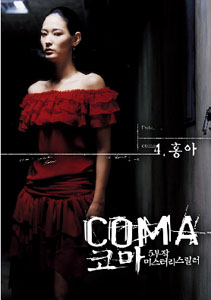 Ha! Remember how I complained about how the pragmatic view of the policeman seemed to drag the story away from the supernatural. Well, this chapter brings the story back into the realm of ghosts with a vengeance. We are introduced to Hong-ah, an artist who sees visions of ghosts as part of her daily life. She wear headphones to avoid hearing them. She wears sunglasses and keeps her head down to avoid seeing them. But it is not enough. One particular ghost has been reaching out…violently..to her with the plea of “Kill me.”
Ha! Remember how I complained about how the pragmatic view of the policeman seemed to drag the story away from the supernatural. Well, this chapter brings the story back into the realm of ghosts with a vengeance. We are introduced to Hong-ah, an artist who sees visions of ghosts as part of her daily life. She wear headphones to avoid hearing them. She wears sunglasses and keeps her head down to avoid seeing them. But it is not enough. One particular ghost has been reaching out…violently..to her with the plea of “Kill me.”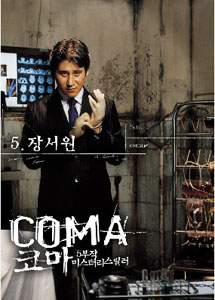 Originally posted May 17, 2009–This is the final chapter of a five part series. If you are reading this after all the reviews have been posted, you might want to go down and start with episode one. There are some spoilers in these but I am trying to avoid ruining the film for anyone who decides they want to track down the DVDs.
Originally posted May 17, 2009–This is the final chapter of a five part series. If you are reading this after all the reviews have been posted, you might want to go down and start with episode one. There are some spoilers in these but I am trying to avoid ruining the film for anyone who decides they want to track down the DVDs.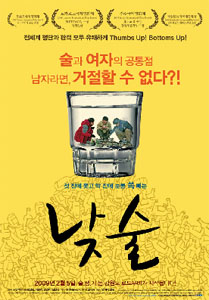 Originally posted July 12, 2009–Daytime Drinking is yet more proof that a huge budget and well-known actors are NOT needed to create an excellent, entertaining film. The poster indicates that it has won several prizes at film festivals including the 2008 Jeonju International Film Festival’s JJ Star Award and the 2008 Locarno International Film Festival’s Netpac Award as well as being invited to compete at the Toronto and Thessaloniki International Film Festivals which indicates a high degree of critical acclaim as well. It is well-deserved. Director NoYeong-seok is a name to watch for in the future. Calling him merely ‘director’ is not really fair to Mr. No because he didn’t only direct this film. He was the producer, the cinematographer, the editor, the writer…he even wrote the music. What is equally amazing is that he, and all the actors in this film, have no other movie credits to their names. This is the first film for all involved and I hope to see more in the near future.
Originally posted July 12, 2009–Daytime Drinking is yet more proof that a huge budget and well-known actors are NOT needed to create an excellent, entertaining film. The poster indicates that it has won several prizes at film festivals including the 2008 Jeonju International Film Festival’s JJ Star Award and the 2008 Locarno International Film Festival’s Netpac Award as well as being invited to compete at the Toronto and Thessaloniki International Film Festivals which indicates a high degree of critical acclaim as well. It is well-deserved. Director NoYeong-seok is a name to watch for in the future. Calling him merely ‘director’ is not really fair to Mr. No because he didn’t only direct this film. He was the producer, the cinematographer, the editor, the writer…he even wrote the music. What is equally amazing is that he, and all the actors in this film, have no other movie credits to their names. This is the first film for all involved and I hope to see more in the near future.